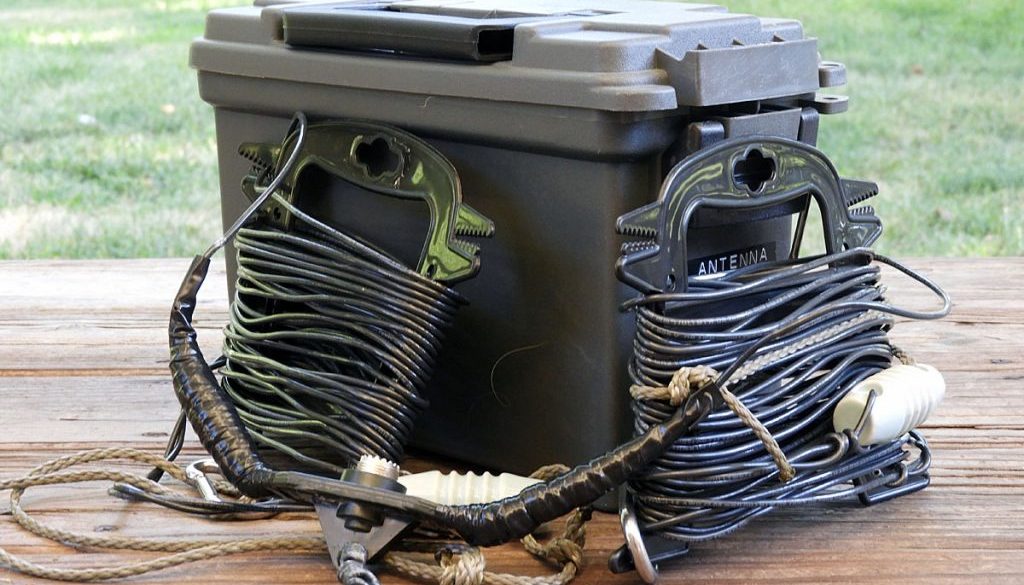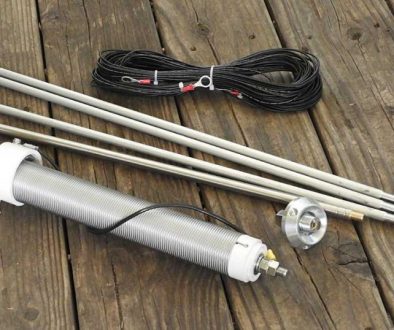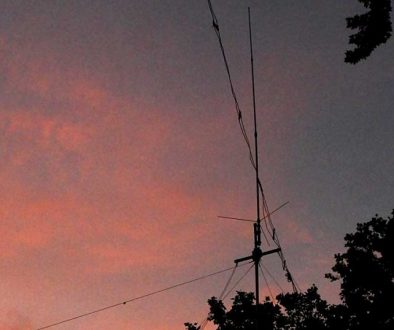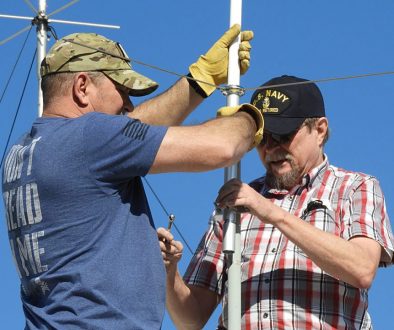Field Day 2019 – 40 Meter Inverted V Build
For this 2019 Field Day project, I wanted to build a 40 Meter inverted V dipole antenna that could be easily deployed in the field. 
It was designed and tuned for a target frequency of 7.237 Mhz.
Using the formula 468 / 7.237=64.66 total length. I added 4′ for connection winds and a little slack that could be trimmed during tuning if necessary.
My research into antenna making led me to many people that promoted using inexpensive small gauge steel electric fence wire for the antenna elements. I chose not to go that route and instead used Southwire 55667123 Primary Wire, 14-Gauge, Black insulated wire for the antenna elements (each leg 33.5′). That wire is much easier to handle with fewer twists and kinks.
 What I wanted was something simple and low cost I could use for a center insulator. There were numerous commercial insulators like those from MFJ available as well as lots of examples of build-it-yourself PVC designs. All were quite interesting, but then I discovered something I hadn’t seen before. What I found was the Budwig HQ-1 Center Insulator with SO-239 UHF Female Connector and two ceramic dogbone insulators for about $20. Simple and relatively low cost.
What I wanted was something simple and low cost I could use for a center insulator. There were numerous commercial insulators like those from MFJ available as well as lots of examples of build-it-yourself PVC designs. All were quite interesting, but then I discovered something I hadn’t seen before. What I found was the Budwig HQ-1 Center Insulator with SO-239 UHF Female Connector and two ceramic dogbone insulators for about $20. Simple and relatively low cost.
 Constructing 40 meter inverted V
Constructing 40 meter inverted V
I bent the ends of the insulator at an angle approximating the angle for the two end connections. I next soldered each antenna element to the insulator. To keep it waterproofed, I wrapped the connections with X-Treme Tape TPE-XR1510ZLB Silicone Rubber Self Fusing Tape.
Now I had a lightweight portable antenna that easily wound onto two hand spools and fit neatly inside a Harbor Freight Ammo Box. Total cost of less than $40.
I deployed the antenna in my back yard in a less than desirable situation to get the antenna tuned to my target frequency and practice setting up on a fiberglass pole mast. After a few minutes with the MFJ-Analyzer, I trimmed a few inches off the end and had the antenna resonate at my desired frequency. I ended up with each leg being 32.5′. Took it down and packed it away for Field Day.
I planned on joining the Flint Hills Amateur Radio Club group for Field Day on Saturday and overnight until Sunday. This was to be my first time deploying the Military style fiberglass poles in a real world environment in the field. To elevate the center of the antenna to 32′ required 8 poles and another three for the tri-pod base. 6 more poles were used for the two supports for the ends of the antenna.

On Friday night before Field Day, the club cancelled the outdoor event because we were expecting severe weather on Sat/Sun. However we were still invited out Saturday for a cookout of the food already purchased before the storms rolled in. Since I already packed my Jeep for Field Day, I joined the group late Saturday morning. Barb (KD0WAU) and Wayne (KD0WAT) had already put up an antenna for their radio so I said, “What the heck.” I had planned for this event for months and decided to take advantage of the presently calm weather.
 Several others joined in to help me put up my antenna and in no time I was on the air. I made several contacts and a couple other people made a few contacts each.
Several others joined in to help me put up my antenna and in no time I was on the air. I made several contacts and a couple other people made a few contacts each.
The farthest contact made from my station was 541 miles into Texas. Had quite a few contacts in Texas and others in Missouri, Nebraska, Iowa, and Illinois. This setup seemed to work great for regional contacts.
By mid-afternoon the clouds began rolling in and bad weather threatened so everyone decided to shut down and head home. While it was a shortened Field Day, I did accomplish my goals to deploy in the field using only battery power to make contacts.
I considered this Field Day a “success” since I was able to successfully deploy my antenna and operate my IC-7300 off a 12-volt battery.



